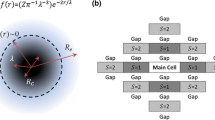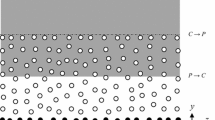Abstract
In this paper, we present an extension of dissipative particle dynamics method in order to study the mixed electroosmotic/pressure-driven micro- or nano-flows. This method is based on the Poisson–Boltzmann equation and has a great potential to resolve the electric double layer (EDL). Hence, apart from studying the bulk flow, it also provides a strong capability in order to resolve the complex phenomena occur inside the EDL. We utilize the proposed method to study the pure electroosmotic and also the mixed electroosmotic/pressure-driven flow through the straight micro-/nano-channels. The obtained results are in good agreement with the available analytical solutions. Furthermore, we study the electroosmotic flow and motion of DNA molecules through a T-shaped micro-channel. We show that neglecting the EDL and utilizing the slip wall boundary condition model can result in crucially misleading hydrodynamic characteristics if the EDL is comparable to the width of the channel. Finally, we utilize the presented method in order to study the complex flow patterns, which are created due to the heterogeneous distribution of the electric potential of the walls. These complex flow patterns usually are utilized in order to enhance the efficiency of mixing process in micro-/nano-length scales. In addition, we show that they can also be utilized effectively in order to separate the different macro-molecules such as polymers, DNA molecules and so on, according to their length of chain.

















Similar content being viewed by others
References
Aboelkassem Y (2011) Numerical simulation of electroosmotic complex flow patterns in a microchannel. Comput Fluids 52:104
Ajdari A (1995) Electro-osmosis on inhomogeneously charged surfaces. Phys Rev Lett 75:755
Ajdari A (1996) Generation of transverse fluid currents and forces by an electric field: electro-osmosis on charge-modulated and undulated surfaces. Phys Rev E 53:4996
Arulanandam S, Li D (2000) Liquid transport in rectangular microchannels by electroosmotic pumping. Coll Surf A 161:89
Cao Q, Zuo C, Li L, Ma Y, Li N (2010) Electroosmotic flow in a nanofluidic channel coated with neutral polymers. Microfluid Nanofluid 9:1051
Cao Q, Zuo C, Li L, Yang Y, Li N (2011) Controlling electroosmotic flow by polymer coating: a dissipative particle dynamics study. Microfluid Nanofluid 10:977
Cao Q, Zuo C, Li L, Zhang Y, Yan G (2012) Electro-osmotic flow in nanochannels with voltage-controlled polyelectrolyte brushes: Dependence on grafting density and normal electric field. J Poly Sci Part B Poly Phys 50:805
Chai Z, Shi B (2007) Simulation of electro-osmotic flow in microchannel with lattice Boltzmann method. Phys Lett A 364:183
Duong-Hong D, Han J, Wang JS, Hadjiconstantinou NG, Chen YZ, Liu GR (2008) Realistic simulations of combined DNA electrophoretic flow and EOF in nano-fluidic devices. Electrophoresis 29:4880
Duong-Hong D, Wang JS, Liu GR, Chen YZ, Han J, Hadjiconstantinou NG (2008) Dissipative particle dynamics simulations of electroosmotic flow in nano-fluidic devices. Microfluid Nanofluid 4:219
Dutta P, Beskok A (2001) Analytical solution of combined electroosmotic/pressure driven flows in two-dimensional straight channel. Anal Chem 73:1979
Dutta P, Beskok A, Warburton TC (2002) Numerical simulation of mixed electroosmotic/pressure driven microflows. Numer Heat Transf 41:131
Espanol P, Warren P (1995) Statistical mechanics of dissipative particle dynamics. Europhys Lett 30:191
Ghosal S (2004) Fluid mechanics of electroosmotic flow and its effect on band broadening in capillary electrophoresis. Electrophoresis 25:214
Groot RD (2003) Electrostatic interactions in dissipative particle dynamics simulation of polyelectrolytes and anionic surfactants. J Chem Phys 118:11,265
Groot RD, Warren PB (1997) Dissipative particle dynamics: bridging the gap between atomic and mesoscopic simulation. J Chem Phys 107(11):4423
Hadigol M, Nosrati R, Nourbakhsh A, Raisee M (2011) Numerical study of electroosmotic micromixing of non-newtonian fluids. J Nonnewton Fluid Mech 166:965
Han J, Craighead H (2000) Separation of long DNA molecules in a microfabricated entropic trap array. Science 288(5468):1026
Han J, Turner S, Craighead H (1999) Entropic trapping and escape of long DNA molecules at submicron size constriction. Phys Rev Lett 83(8):1688
Hickey OA, Harden JL, Slater GW (2009) Molecular dynamics simulations of optimal dynamic uncharged polymer coatings for quenching electro-osmotic flow. Phys Rev Lett 102:108,304
Hickey OA, Harden JL, Slater GW (2012) Computer simulations of time-dependent suppression of EOF by polymer coatings. Microfluid Nanofluid 13:91
Hickey OA, Holm C, Harden JL, Slater GW (2011) Influence of charged polymer coatings on electro-osmotic flow: Molecular dynamics simulations. Macromolecules 44:9455
Horiuchi K, Dutta P, Richards CD (2007) Experiment and simulation of mixed flows in a trapezoidal microchannel. Microfluid Nanofluid 3:347
Ibergay C, Malfreyt P, Tildesley DJ (2010) Mesoscale modeling of polyelectrolyte brushes with salt. J Phys Chem B 114:7274
Jiang W, Huang J, Wang Y, Laradji M (2007) Hydrodynamic interaction in polymer solutions simulated with dissipative particle dynamics. J Chem Phys 126:044,901
Karniadakis G, Beskok A, Aluru N (2005) Microflows and nanoflows fundamentals and simulation. Springer Science+Business Media, Inc., Berlin
Liu X, Erickson D, Li D, Krull UJ (2004) Cationic polymer coatings for design of electroosmotic flow and control of DNA adsorption. Anal Chim Acta 507:55
Long D, Dobrynin AV, Rubinstein M, Ajdari A (1998) Electrophoresis of polyampholytes. J Chem Phys 108:1234
McMahon G (2007) Analytical instrumentation: a guide to laboratory, portable and miniaturized instruments. Wiley, New Jersey
Mehboudi A, Saidi MS (2011) A systematic method for the complex walls no-slip boundary condition modeling in dissipative particle dynamics. Scientia Iranica B 18:1253
Mehboudi A, Saidi MS (2013) Physically-based wall boundary condition for dissipative particle dynamics. Microfluid Nanofluidics. doi: 10.1007/s10404-013-1285-7
Mishchuk NA, Heldal T, Volden T, Auerswald J, Knapp H (2011) Microfluidic pump based on the phenomenon of electroosmosis of the second kind. Microfluid Nanofluidics 11:675
Moeendarbary E, Ng T, Pan H, Lam K (2010) Migration of DNA molecules through entropic trap arrays: a dissipative particle dynamics study. Microfluid Nanofluidics 8:243
Pan H, Ng T, Li H, Moeendarbary E (2010) Dissipative particle dynamics simulation of entropic trapping for DNA separation. Sens Actuat A Phys 157:328
Patankar NA, Hu HH (1998) Numerical simulation of electroosmotic flow. Anal Chem 70:1870
Pennathur S, Santiago JG (2005) Electrokinetic transport in nanochannels. 2. experiments. Anal Chem 77:6782
Qiao R (2006) Control of electroosmotic flow by polymer coating: Effects of the electrical double layer. Langmuir 22:7096
Qiao R, He P (2007) Modulation of electroosmotic flow by neutral polymers. Langmuir 23:5810
Smiatek J, Schmid F (2011) Mesoscopic simulations of electroosmotic flow and electrophoresis in nanochannels. Comput Phys Commun 182:1941
Smiatek J, Sega M, Holm C, Schiller UD, Schmid F (2009) Mesoscopic simulations of the counterion-induced electro-osmotic flow: a comparative study. J Chem Phys 130:244,702
Streek M, Schmid F, Duong TT, Ros A (2004) Mechanisms of DNA separation in entropic trap arrays: a brownian dynamics simulation. J Biotechnol 112:79
Symeonidis V, Karniadakis GE, Caswell B (2005) Dissipative particle dynamics simulations of polymer chains: Scaling laws and shearing response compared to DNA experiments. Phys Rev Lett 95:076,001
Tessier F, Slater G (2005) Control and quenching of electroosmotic flow with end-grafted polymer chains. Macromolecules 38:6752
Tessier F, Slater G (2006) Modulation of electroosmotic flow strength with end-grafted polymer chains. Macromolecules 39:1250
Viovy JL (2000) Electrophoresis of DNA and other polyelectrolytes: physical mechanisms. Rev Mod Phys 73(3):813
Zhang Z, Zuo C, Cao Q, Ma Y, Chen S (2012) Modulation of electroosmotic flow using polyelectrolyte brushes: A molecular dynamics study. Macromol Theory Simul 21:145
Zhou T, Liu AL, He FY, Xia XH (2006) Time-dependent starting profile of velocity upon application of external electrical potential in electroosmotic driven microchannels. Coll Surf A Physicochem Eng Aspects 277:136
Zhu J, Canter RC, Keten G, Vedantam P, Tzeng TRJ, Xuan X (2011) Continuous-flow particle and cell separations in a serpentine microchannel via curvature-induced dielectrophoresis. Microfluid Nanofluid 11:743
Author information
Authors and Affiliations
Corresponding author
Rights and permissions
About this article
Cite this article
Mehboudi, A., Noruzitabar, M. & Mehboudi, M. Simulation of mixed electroosmotic/pressure-driven flows by utilizing dissipative particle dynamics. Microfluid Nanofluid 17, 199–215 (2014). https://doi.org/10.1007/s10404-013-1287-5
Received:
Accepted:
Published:
Issue Date:
DOI: https://doi.org/10.1007/s10404-013-1287-5




